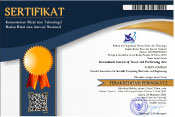*corresponding author
AbstractThe preservation and transmission of talempong pacik music culture have a significant impact on the preservation of Minangkabau music culture. In addition, on a national scale, it contributes to the promotion of the healthy growth of the national culture. This research seeks to determine how the protection and inheritance model of the Minangkabau talempong pacik has evolved in the Internet era. The necessary data consist of (1) Minangkabau talempong pacik data and (2) talempong pacik inheritance pattern data. Literature review and observation of talempong pacik music performances on digital platforms such as YouTube, Instagram, and Facebook provided the data. The analysis is conducted by stressing the pattern resulting from the talempong pacik's maintenance and transmission. Ultimately, the results of this study show that the quality of talempong pacik's musical legacy will improve greatly as a result of the extensive and continuous use of new media to assist its preservation. New media used to study traditional talempong pacik music, including videos of talempong pacik performances, animation of talempong musical instrument games, and talempong pacik music software as a form of learning innovation, demonstrate that the quality of inheritance is highly adaptable to technological advancements
KeywordsInternet-era; Protection and inheritance; Talempong pacik; New media; Music technology
|
DOIhttps://doi.org/10.31763/viperarts.v4i1.735 |
Article metrics10.31763/viperarts.v4i1.735 Abstract views : 1481 | PDF views : 550 |
Cite |
Full Text Download Download
|
References
[1] R. J. Chadwick, “Matrilineal Inheritance and Migration in a Minangkabau Community,†Indonesia, vol. 51, no. 51, p. 47, Apr. 1991, doi: 10.2307/3351065.
[2] A. Mustikawati and K. S. Astuti, “Bringing 21st century music skills to the curriculum through interdisciplinary study,†in 21st Century Innovation in Music Education, Routledge, 2019, pp. 174–179. doi: 10.1201/9780429024931-23
[3] J. Fraser, “Musical Journeys in Sumatra by Margaret Kartomi,†Asian Music, vol. 46, no. 2, pp. 127–130, 2015, doi: 10.1353/amu.2015.0019.
[4] J. Fraser, “Pop Song as Custom: Weddings, Ethnicity, and Entrepreneurs in West Sumatra,†Ethnomusicology, vol. 55, no. 2, pp. 200–228, May 2011, doi: 10.5406/ethnomusicology.55.2.0200.
[5] A. F. Yusman, “Talempong Pacik As Kinship Solidarity Unifier In Nagari Bungo Tanjuang Batipuh Sub-Disrict Tanah Datar District,†SOSHUM J. Sos. dan Hum., vol. 11, no. 1, pp. 13–19, Mar. 2021, doi: 10.31940/soshum.v11i1.2263.
[6] M. Irfan and A. S. Suminto, “Talempong Anam Salido as an Islamic representation of Minangkabau people,†in 21st Century Innovation in Music Education, Routledge, 2019, pp. 526–531. doi: 10.1201/9780429024931-69
[7] D. R. Heise, “Affect control theory: Concepts and model,†in Analyzing Social Interaction, Routledge, 2016, pp. 1–34. doi: 10.4324/9781315025773-1
[8] X. Zhou, “Music Education and Music Inheritance in Multicultural Context,†in Proceedings of the 2017 2nd International Conference on Education, Sports, Arts and Management Engineering (ICESAME 2017), 2017, pp. 1890–1894, doi: 10.2991/icesame-17.2017.401.
[9] J. Gefaell and C. Saborido, “Incommensurability and the Extended Evolutionary Synthesis: taking Kuhn seriously,†Eur. J. Philos. Sci., vol. 12, no. 2, p. 24, Jun. 2022, doi: 10.1007/s13194-022-00456-y.
[10] D. J. Shevock, “Satis Coleman—A Spiritual Philosophy for Music Education,†Music Educ. J., vol. 102, no. 1, pp. 56–61, Sep. 2015, doi: 10.1177/0027432115590182.
[11] Z. Sun, “Analysis of the Inheritance of Traditional Music Culture Based on Big Data Auxiliary Technology,†J. Phys. Conf. Ser., vol. 1648, no. 4, pp. 1–6, Oct. 2020, doi: 10.1088/1742-6596/1648/4/042029.
[12] A. Kaun, “Ways of seeing digital disconnection: A negative sociology of digital culture,†Converg. Int. J. Res. into New Media Technol., vol. 27, no. 6, pp. 1571–1583, Dec. 2021, doi: 10.1177/13548565211045535.
[13] J. Haider and O. Sundin, “Information literacy challenges in digital culture: conflicting engagements of trust and doubt,†Information, Commun. Soc., vol. 25, no. 8, pp. 1176–1191, Jun. 2022, doi: 10.1080/1369118X.2020.1851389.
[14] I. Levin and D. Mamlok, “Culture and Society in the Digital Age,†Information, vol. 12, no. 2, pp. 1–13, Feb. 2021, doi: 10.3390/info12020068.
[15] M. Reyaz, “New Media, Identity and Minorities: The Role of Internet in Mainstreaming of Muslims in India,†in Inhabiting Cyberspace in India, Singapore: Springer Singapore, 2021, pp. 57–68. doi: 10.1007/978-981-15-9934-7_6
[16] N. Karakayali and B. Alpertan, “Mood playlists, biopower, and the ‘functional turn’ in online media: What happens when a pre-digital social control technology is transferred to the internet?,†Inf. Soc., vol. 37, no. 1, pp. 20–34, Jan. 2021, doi: 10.1080/01972243.2020.1826616.
[17] Q. Shi, “The Study on the Development of Traditional Music in Internet Age,†in 2021 The 5th International Conference on Algorithms, Computing and Systems, 2021, pp. 1–5, doi: 10.1145/3490700.3490701.
[18] J. Shively, “Constructivism in Music Education,†Arts Educ. Policy Rev., vol. 116, no. 3, pp. 128–136, Jul. 2015, doi: 10.1080/10632913.2015.1011815.
[19] R. A. Rehfeldt, I. Tyndall, and J. Belisle, “Music as a Cultural Inheritance System: A Contextual-Behavioral Model of Symbolism, Meaning, and the Value of Music,†Behav. Soc. Issues, vol. 30, no. 1, pp. 749–773, Dec. 2021, doi: 10.1007/s42822-021-00084-w.
[20] A. Camurri, M. Frixione, and C. Innocenti, “A Cognitive Model and a Knowledge Representation System for Music and Multimedia,†J. New Music Res., vol. 23, no. 4, pp. 317–347, Dec. 1994, doi: 10.1080/09298219408570663.
Refbacks
- There are currently no refbacks.
Copyright (c) 2022 Teti Darlenis

This work is licensed under a Creative Commons Attribution-ShareAlike 4.0 International License.
___________________________________________________________
International Journal of Visual and Performing Arts
ISSN 2684-9259
Published by Association for Scientific Computing Electronics and Engineering (ASCEE)
W: http://pubs2.ascee.org/index.php/viperarts
E: sularso@ascee.org
Organized by:
 This work is licensed under a Creative Commons Attribution-ShareAlike 4.0
This work is licensed under a Creative Commons Attribution-ShareAlike 4.0
























